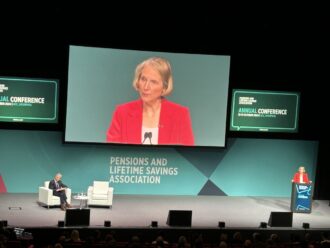Asset owners are fixated with fixed income again due to growing pessimism over the prospects of the global economy and risk assets in the coming year, according to a survey.
The study of UK, European and Asian asset owners also found that they foresee much uncertainty amid unresolved economic issues, with diverging expectations for growth, inflation and monetary policy.
Despite ongoing uncertainty, improved fixed income fundamentals have sparked renewed interest in the asset class, with asset owners and other investors expected to boost bond allocations – 58% indicated an intention to increase allocations versus 7% who expect to reduce their exposure.
Within that interest in fixed income, half of respondents are set to boost positions in green bonds and investment-grade credit over the next year, followed by sovereign debt at 43% of respondents, according to the survey from PGIM Investments.
The primary regional difference between asset owners was within emerging market debt, with 51% of Asian asset owners set to increase exposure to the asset class, compared to just 36% for their European peers.
Fixed fashion
Pension funds see much that is positive with bonds, as the fixed income outlook chimes with Border to Coast’s fixed income portfolio manager Daniel Loughney. “Fixed income is back in fashion, competing as an alternative investment to traditionally higher yielding riskier assets from a return perspective, as opposed to just portfolio diversification,” he said.
The pensions pool believes that as a long-term investor, bonds, including those that are inflation linked, provide ‘a two birds with one stone’ opportunity. “Generating attractive income and also helping to match a portion of liabilities,” Loughney said.
He noted that medium-dated gilts now yield 4.5%. With inflation metrics slowing and bond volatility falling, gilts are appealing, with index-linked bonds – where coupons are linked to inflation – looking compelling with a real yield above 1%. Credit spreads over government bonds have widened as yields have increased, leading other fixed income sectors to offer attractive valuations for their risk profile.
Similarly, while investors have been challenged by the increasingly correlated performance of bonds and equities, more than two-thirds of asset owners believe fixed income will reclaim its long-held role as a portfolio diversifier to stock volatility.
While interest rates have spent more than a decade at ultra-low levels, expectations are that developed market rates are set for a sustained period hovering within the range of 3% to 5%.
Search for yield
Should this materialise, investment-grade returns should be in the mid-single digits for the foreseeable future, with high-single-digit returns for higher-risk sectors.
Matt Shafer, head of international distribution at PGIM Investments, said: “With the majority of rate hikes now in the rear-view mirror, we could also see reduced fixed income volatility and a reemergence of the search for yield – which can provide an additional performance boost for bond strategies.”
Newton Investment Management’s head of mixed assets, Paul Flood, shares his enthusiasm for bonds. “We now see bonds offering higher yields and providing better diversification as part of a multi-asset portfolio. We’ve even gone so far as to herald the ‘rebirth’ of the 60/40 portfolio,” he said.
In this environment, Flood said there is real potential to make decent returns in the bond market. “We have reduced the exposure to alternatives, choosing to reallocate resources up the capital structure in the bond market, given bonds’ attractive- ness as an income-producing investment,” he said.
So bonds are buyable again based on their potential to generate returns and for diversification. “In our view, bonds should once again play a role in a well-diversified portfolio, one that also keeps exposure to growth opportunities within equity markets, and to real assets that can provide an attractive level of yield in the inflationary environment,” Flood added.
Top of the list
But where should investors look within fixed income? Having studied the trends in the bond market, Nigel Jenkins, managing director at asset management boutique Payden & Rygel, believes that he has the answers, citing the US as being close to the top of the list for investors looking at bonds, particularly treasuries, with TIPs, or inflation-linked treasuries.
Investors can get a 1.9% yield on a 10-year inflation protected security backed by the US treasury, Jenkins said. With inflation risk down, there’s still more of it than there has been at any other time in the last 20 years, he added.
The argument Jenkins presents is that if investors can get close to a 2% guaranteed yield in excess of whatever inflation turns out to be, with the backing of the US treasury over 10 years, that is a decent real yield. “That’s a higher real yield than you can get in most other markets as well,” Jenkins said.
The move to bonds has occurred at a rapid rate. It comes after 2022 saw one of worst bond market selloffs in a generation after central banks aggressively raised interest rates to contain inflation.





Comments